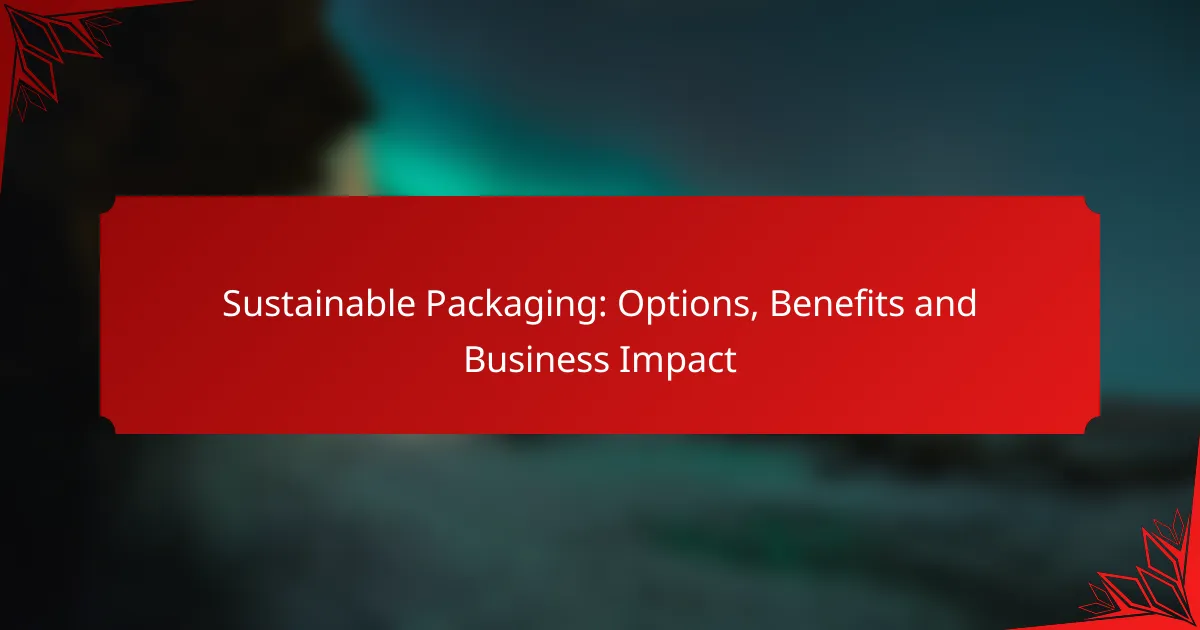Sustainable packaging options are designed to minimize environmental impact while ensuring functionality, focusing on waste reduction, recyclability, and renewable resources. By adopting these alternatives, businesses can enhance their brand reputation, achieve long-term cost savings, and improve operational efficiency, ultimately leading to increased customer loyalty and market share.
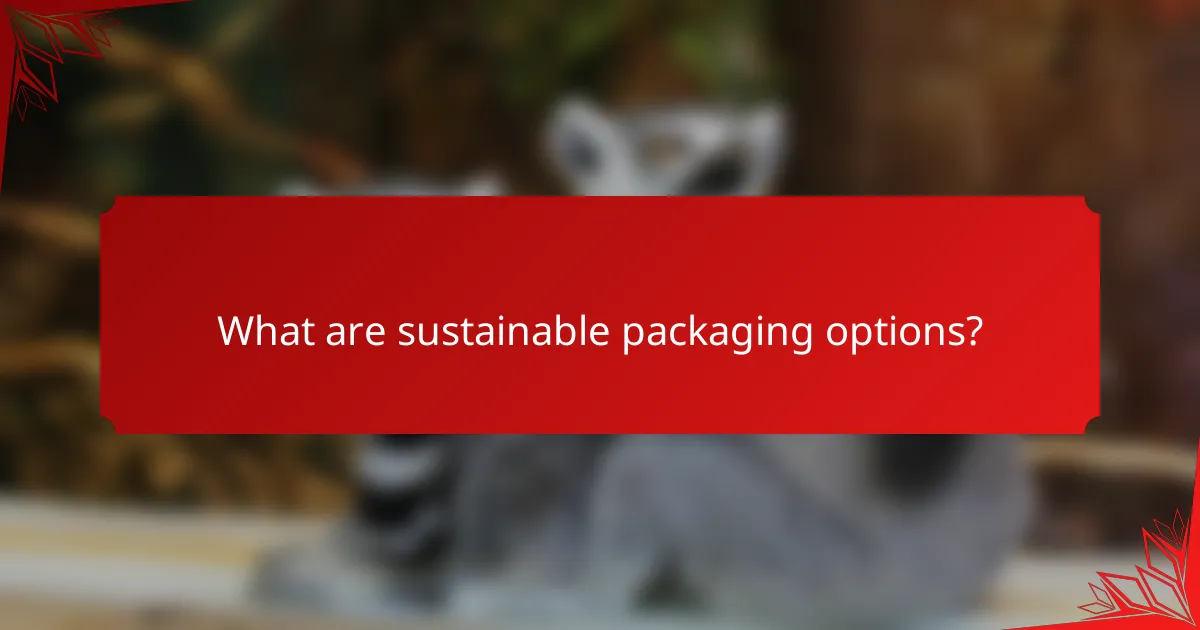
What are sustainable packaging options?
Sustainable packaging options are materials and designs that minimize environmental impact while maintaining functionality. These alternatives focus on reducing waste, enhancing recyclability, and utilizing renewable resources.
Biodegradable materials
Biodegradable materials break down naturally through the action of microorganisms, typically within a few months to a couple of years, depending on conditions. Common examples include paper, certain bioplastics, and plant-based fibers. When selecting biodegradable options, consider the disposal environment to ensure effective degradation.
Businesses should be aware that not all biodegradable materials are created equal; some require industrial composting facilities to decompose effectively, which may not be available in all areas.
Recyclable packaging
Recyclable packaging is designed to be processed and reused in the production of new materials. Common recyclable materials include glass, aluminum, and specific plastics marked with recycling symbols. To maximize recycling rates, ensure that packaging is clean and free from contaminants before disposal.
Understanding local recycling guidelines is crucial, as acceptance of materials can vary significantly by region. Businesses can enhance their sustainability profile by using materials that are widely accepted in local recycling programs.
Compostable solutions
Compostable solutions are designed to break down into natural elements in a composting environment, enriching the soil without leaving harmful residues. These materials often include specific bioplastics and organic materials like cornstarch. For effective composting, it’s essential to ensure that the composting facility can handle these materials.
Companies should consider labeling their compostable packaging clearly to educate consumers on proper disposal methods, as confusion can lead to contamination in composting systems.
Reusable containers
Reusable containers are designed for multiple uses, significantly reducing waste over time. Examples include glass jars, metal tins, and durable plastic containers. Businesses can encourage customers to return or refill containers, fostering a circular economy.
Implementing a take-back program or offering incentives for returning containers can enhance customer participation and promote sustainability. Ensure that the materials used are durable and easy to clean to maximize their lifespan.
Plant-based plastics
Plant-based plastics are derived from renewable resources such as corn, sugarcane, or potato starch. These materials can reduce reliance on fossil fuels and lower carbon emissions during production. However, it’s essential to assess the entire lifecycle of plant-based plastics, including agricultural practices and land use.
When considering plant-based plastics, businesses should evaluate their performance characteristics compared to traditional plastics, such as durability and barrier properties, to ensure they meet product requirements without compromising sustainability goals.
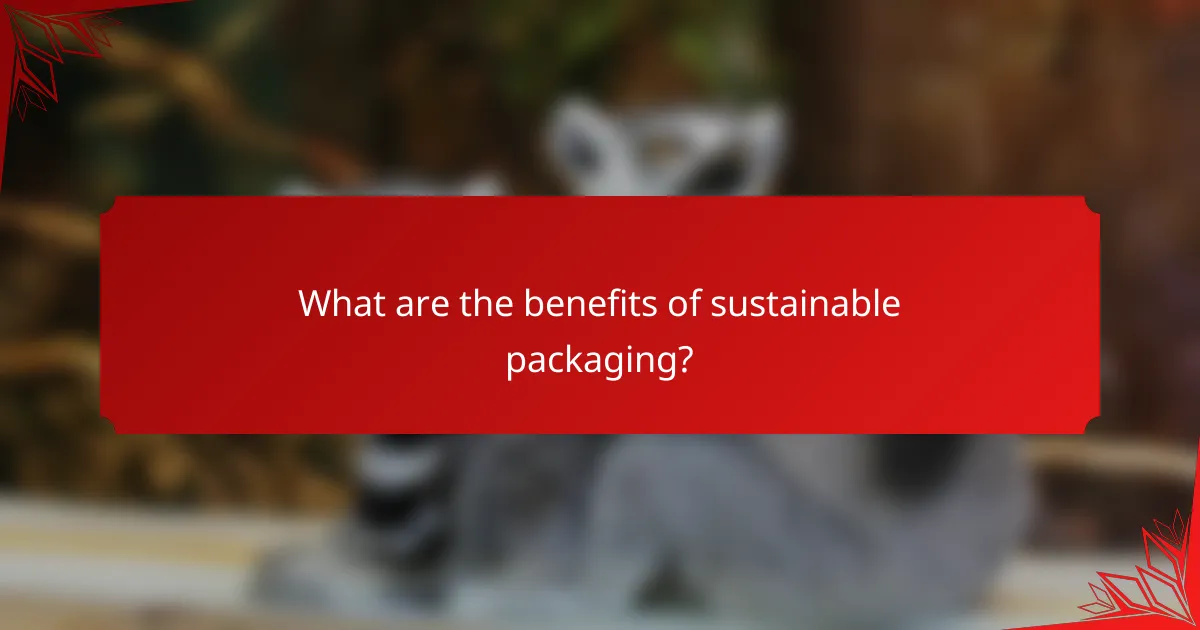
What are the benefits of sustainable packaging?
Sustainable packaging offers numerous advantages, including reduced environmental impact, enhanced brand reputation, long-term cost savings, and compliance with regulations. These benefits can significantly influence a company’s operational efficiency and market positioning.
Reduced environmental impact
Sustainable packaging minimizes waste and pollution by using materials that are recyclable, biodegradable, or made from renewable resources. This approach helps decrease the carbon footprint associated with production and disposal, contributing to a healthier planet.
For example, switching from plastic to paper or plant-based materials can significantly lower the environmental toll. Companies can also implement practices like using less packaging overall or optimizing package design to reduce material usage.
Enhanced brand reputation
Adopting sustainable packaging can improve a company’s image and attract environmentally conscious consumers. Brands that prioritize sustainability often gain customer loyalty and positive word-of-mouth, which can lead to increased sales.
Highlighting sustainable practices in marketing materials and on product labels can further enhance brand perception. Consumers are more likely to support businesses that demonstrate a commitment to environmental responsibility.
Cost savings in the long term
While the initial investment in sustainable packaging may be higher, companies can achieve significant cost savings over time. Reduced material costs, lower waste disposal fees, and potential tax incentives for eco-friendly practices can offset initial expenses.
Additionally, efficient packaging can lead to savings in shipping costs due to lighter and more compact designs. Companies should evaluate their supply chain to identify opportunities for cost reductions through sustainable practices.
Compliance with regulations
Many regions are implementing stricter regulations regarding packaging waste and environmental impact. Sustainable packaging helps companies stay ahead of these regulations, avoiding potential fines and ensuring compliance with local laws.
For instance, the European Union has introduced directives aimed at reducing plastic waste, which encourages businesses to adopt more sustainable packaging solutions. Staying informed about regulatory changes can help businesses adapt their packaging strategies proactively.
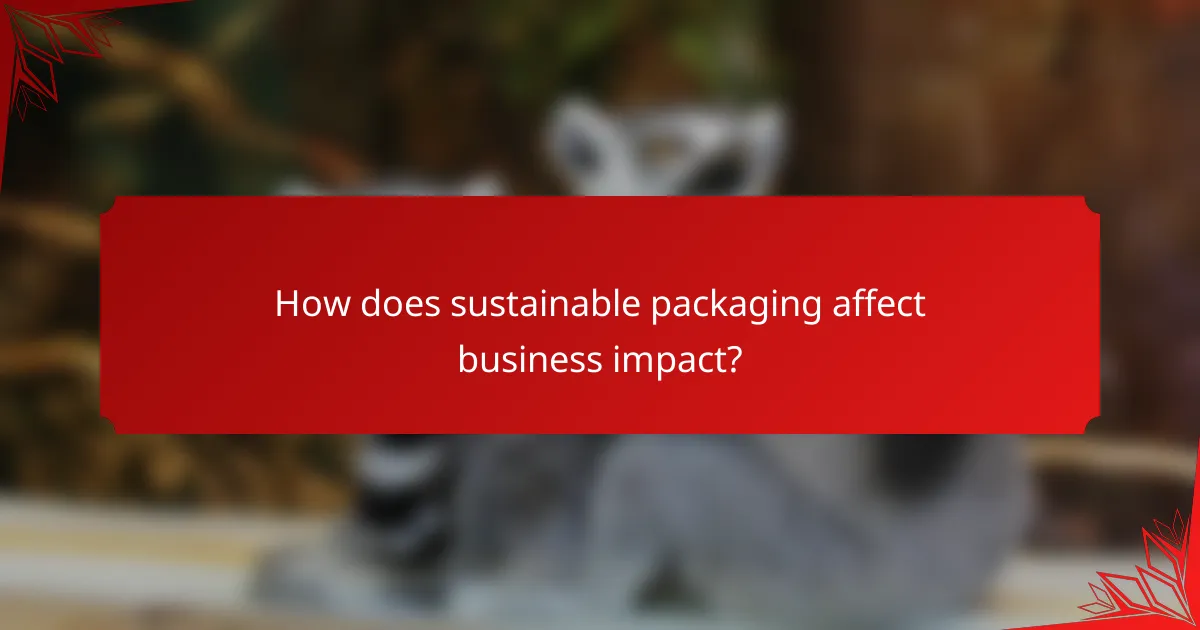
How does sustainable packaging affect business impact?
Sustainable packaging significantly enhances business impact by improving brand reputation and operational efficiency. Companies that adopt eco-friendly packaging often see increased customer engagement and loyalty, leading to higher sales and market share.
Increased customer loyalty
Implementing sustainable packaging can foster stronger customer loyalty. Consumers are increasingly inclined to support brands that prioritize environmental responsibility, which can translate into repeat purchases and positive word-of-mouth.
To capitalize on this trend, businesses should communicate their sustainable packaging efforts clearly. Highlighting certifications or eco-labels can reinforce trust and encourage customers to choose your brand over competitors.
Market differentiation
Sustainable packaging offers a unique opportunity for market differentiation. In crowded markets, brands that utilize eco-friendly materials can stand out, appealing to consumers looking for responsible choices.
Consider using innovative designs or materials that emphasize sustainability, such as biodegradable or recyclable options. This not only attracts attention but also positions your brand as a leader in sustainability.
Attracting eco-conscious consumers
Eco-conscious consumers actively seek out products with sustainable packaging, making it essential for brands to align with this demographic. This group is often willing to pay a premium for products that reflect their values.
To attract these consumers, businesses should focus on transparency regarding their packaging materials and processes. Engaging in marketing campaigns that emphasize sustainability can further enhance appeal and drive sales among this target audience.
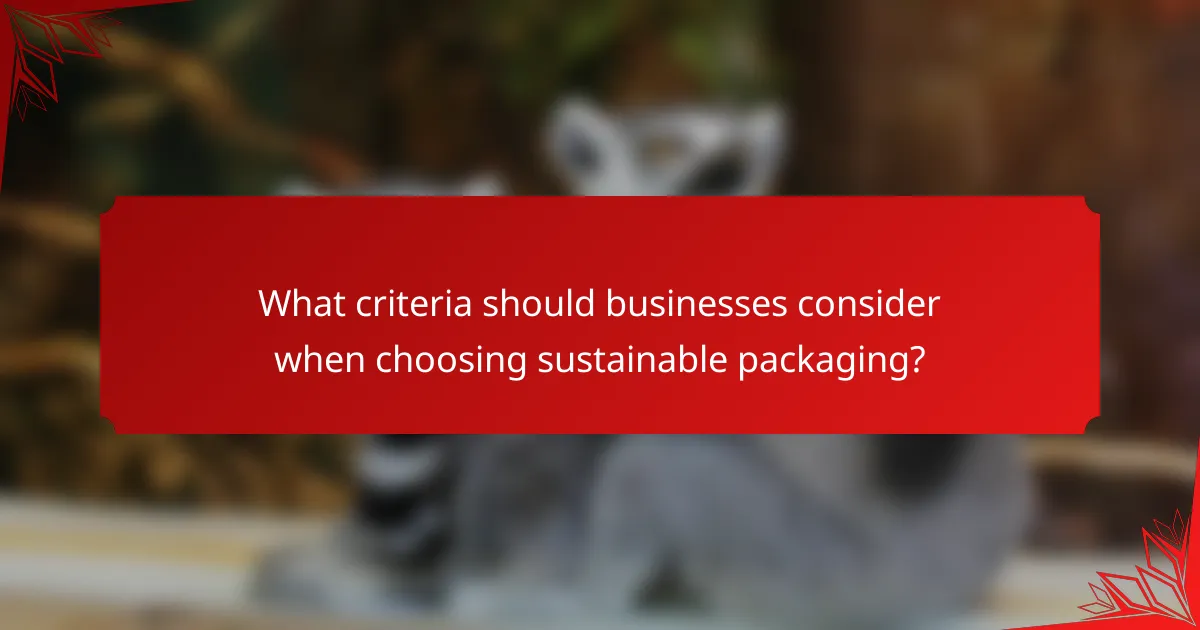
What criteria should businesses consider when choosing sustainable packaging?
Businesses should evaluate several key criteria when selecting sustainable packaging, including material sourcing, supply chain sustainability, and cost-effectiveness. These factors not only influence environmental impact but also affect brand reputation and customer loyalty.
Material sourcing
When considering material sourcing, businesses should prioritize renewable, biodegradable, or recycled materials. For example, packaging made from post-consumer recycled content can significantly reduce waste and resource consumption. Additionally, sourcing materials locally can lower transportation emissions and support regional economies.
It’s essential to verify the sustainability claims of suppliers by looking for certifications such as FSC (Forest Stewardship Council) or Cradle to Cradle. This ensures that the materials are responsibly sourced and meet environmental standards.
Supply chain sustainability
Supply chain sustainability involves assessing the entire lifecycle of the packaging, from production to disposal. Businesses should analyze their suppliers’ practices to ensure they adhere to sustainable methods, such as reducing carbon footprints and minimizing waste. Engaging with suppliers who prioritize sustainability can enhance overall supply chain efficiency.
Implementing a circular economy approach, where materials are reused or recycled, can further strengthen supply chain sustainability. Companies can collaborate with partners to develop take-back programs that encourage customers to return used packaging for recycling or repurposing.
Cost-effectiveness
Cost-effectiveness is a critical factor in choosing sustainable packaging. While initial costs may be higher for eco-friendly materials, businesses should consider the long-term savings from reduced waste disposal fees and potential tax incentives for sustainable practices. Evaluating total cost of ownership rather than just upfront costs can provide a clearer financial picture.
Additionally, businesses can explore bulk purchasing options or partnerships with other companies to lower costs. Regularly reviewing packaging options and staying informed about market trends can help identify more affordable sustainable alternatives as they become available.
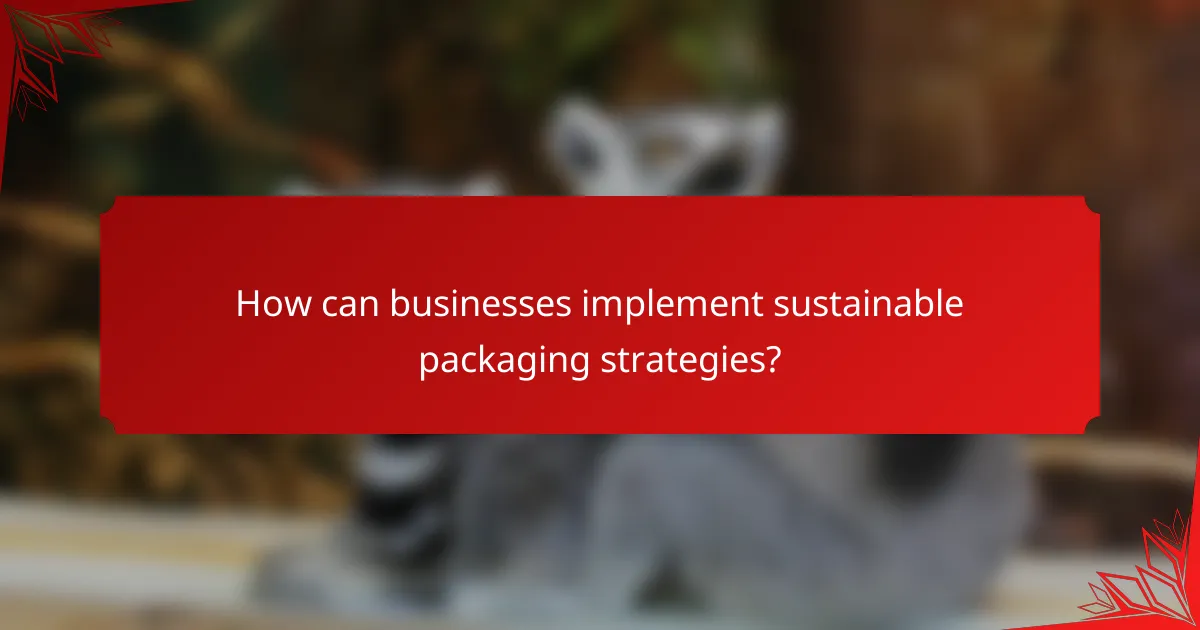
How can businesses implement sustainable packaging strategies?
Businesses can implement sustainable packaging strategies by assessing their current practices, collaborating with suppliers for eco-friendly materials, and educating consumers about the benefits of sustainable choices. These steps not only reduce environmental impact but can also enhance brand reputation and customer loyalty.
Conducting a packaging audit
A packaging audit involves reviewing existing packaging materials and processes to identify areas for improvement. Businesses should evaluate the materials used, the amount of waste generated, and the recyclability of their packaging. This assessment helps pinpoint opportunities to switch to more sustainable options.
During the audit, consider factors such as the carbon footprint of materials, sourcing practices, and compliance with local regulations. Aim for a balance between functionality and sustainability, ensuring that any changes do not compromise product protection or customer experience.
Collaborating with suppliers
Collaboration with suppliers is crucial for sourcing sustainable packaging materials. Businesses should engage with suppliers who prioritize eco-friendly practices and can provide alternatives such as biodegradable plastics or recycled materials. Building strong partnerships can lead to innovative solutions tailored to specific needs.
When selecting suppliers, assess their sustainability certifications and track record. Establish clear communication about sustainability goals and expectations, and consider joint initiatives that promote environmental responsibility throughout the supply chain.
Educating consumers
Educating consumers about sustainable packaging is essential for driving demand and acceptance. Businesses should communicate the benefits of their sustainable packaging choices through marketing materials, product labels, and social media. Highlighting the environmental impact can motivate consumers to choose eco-friendly products.
Consider creating informative content, such as blog posts or videos, that explains the importance of sustainable packaging and how it contributes to a healthier planet. Engaging consumers in sustainability initiatives, such as recycling programs, can further enhance their connection to the brand and its values.
